Perhaps it's a punk-ass way to fill posts, but I do a lot of my longest hunks of writing in the comments threads at other people's blogs. So, in the interests of centralization of production in the finest Soviet style, after the jump are some of my favorite comments-threads participations. In all cases, I'm posting as That Fuzzy Bastard, so a quick search should turn me up fast-like:
On Grand Theft Auto, choice, women, and Brecht
A long discussion of violence, games, genre, and attacking your audience
My Walter Chaw/Armond White 2-minute-Hate---but it's all in the name of civility, I swear!
A little bit about merit pay, teachers' unions, and Obama
On Spike Lee's Clockers and 'hood movies' pretensions
And more Spike Lee, on Crooklyn
Some thoughts on Michael Scott in the US version of The Office
On Guitar Hero and strippers
Oh, and In Cold Blood? That's another book I don't like!
Microsoft and marketing (and also taste)
Quentin Tarantino vs Jean-Luc Godard
The blog of Daniel McKleinfeld, covering games, movies, and whatever else I wanna talk about.
Saturday, June 21, 2008
Thursday, June 12, 2008
Dead Rising: Repetition, Iteration, Repetition
So I finally finished Dead Rising, a game that came out a couple years ago for the Xbox 360. When I say "finished", though, I mean finished twice. Because that's the only way to say I've finished it. Or at least, finished the story. A story. Let me explain...
One of the less-explored components of games as a medium is replayability. As has been explored a lot in visual art, a basic fact of a medium that takes place in computers is that computers are very good at reproducing data. In fact, space and memory limitations mean that repetition of elements is a major aspect of building a digital environment.
In games, that means you have to deal with a lot of very similar-looking items, enemies, and environments. But also, because of the mission-based structure of nearly every game ever made, you frequently have to replay events that happen the same way each time. Obviously, that's true in shumps like The Belgian's beloved Galaga, which are all about learning the patterns. But it's equally true in games with more narrative pretensions---even in a game that's ostensibly a linear narrative, there's always parts that you have to play through again due to dying, which means tediously enduring the cutscenes and dialogue one more time, with the compensation of knowing in advance about the rocket-launcher guy around the ridge who killed you last time.
Dead Rising, though, plays with the option and necessity of replay in an interestingly self-conscious way, making the repetition central to the gameplay experience, and even to its storytelling. Which is appropriate for a game about zombies, those poor, shuffling, post-death bastards, driven by "memory of what they used to do."
In Dead Rising, you play as Frank West, a sleazy photojournalist who's gotten a hot tip about a mysterious outbreak in a small American town. You end up trapped in a shopping mall, together with various survivors and a couple of Dept. of Homeland Security agents who seem to know more than they're telling. From there, you have 72 hours before you're evacuated from the mall (the game happens in realish time, with 2 hours of real time corresponding to one day of game time). At the end of those 72 hours, the game ends, no matter what you've done---it's considered winning the game as long as you just survive the 72 hours, even if you don't do anything else.
Not that there isn't plenty of else to do. The game's missions come in two flavors: story-based missions that reveal the plot, and side missions where you save survivors of the outbreak, put down people who've gone crazy in the mall, or look for "scoops", where you can get dramatic pictures of the carnage.
The problem I initially had with the game is that doing any of the above is really, really difficult. The first time I tried to play through, I was approaching it as one does a game: When given a mission, I would try to complete it, and I pretty much gave up when mission after mission was just too! fucking! hard!!! Fortunately, a gaming guru I know explained the zen of Dead Rising to me: The first time you play, you're not supposed to finish most of the missions---what you're supposed to do is level up in anticipation of the next playthrough.
Y'see, you start Dead Rising with stats for strength, speed, inventory size, and other attributes. Throughout the game, you get experience points (XP) to boost your stats, which makes it possible to finish missions that were too hard before you leveled up. Once you finish a 72-hour play-through, you can then restart the game from the beginning, equipped with your new, more powerful stats, which lets you complete missions that you had to ignore previously. This option is even available within the game---any time you die, you're given the choice of reloading your last save, or restarting the 72 hour period with your most recent stats.
There's a few different ways to get XP in the game. One---the most common---is by taking pictures (photojournalist, remember!), with extra points awarded for composition and content of the pictures (a delightful twist on the first-person view that I wish more games would try). You also get lots of points for finding survivors scattered throughout the mall and convincing them to follow you back to safety, with still more points awarded if you get them there.
But the thing is, on your first play-through, you don't have a chance at actually saving anyone---you just don't have the mojo to keep the zombies away. So if you really want to max out your level points, the winning strategy is to find survivors, promise to get them out of the danger zone, lead them to someplace really exposed, then run to high ground, and... take pictures as the zombies eat them.
And that's every bit as horrible as it sounds, especially since each survivor has their own individual screams and death animations, all of which are quite blood-curdling. This is totally horrible, and you feel like a bad, bad person, even though it's really the parameters of the game that have forced you to make such a dreadful choice.
But it also means you get immensely more satisfaction on your next run through the game, as you find the people you previously condemned to death, and save them from the fate you've already seen. It's sort of comparable to the time-scrambling of John Travolta's death in Pulp Fiction---the medium trumpeting its ability to defy death, even as it makes you aware of the artifice needed to resurrect the dead. Amusingly, my wife (who insists that I refer to her on this blog as "The Fuzzwife") flatly refuses to accept this logic, saying that these people are dead and it's my fault, even though they're alive on the most recent playthrough---the very idea of arguing about whether the first or last playthrough is the real one gives you some idea of the questions of narrative ontology that this game brings up.
A similar logic applies to the game's story missions. The first time through, you won't be able to complete even the first day's missions (the story missions happen in time with the in-game clock---if you're too late to a key spot, you'll miss out on the story). So you develop a mentality of "I don't care why the zombies are here; I just want to survive." But each time you play through, you'll be able to learn more about what's going on, and learning about events often changes the course of them dramatically---the last day in the mall is very, very different based on how many of the story missions you've completed.
Since you can take different missions each time through, each with their own cutscenes, the narrative of each playthrough becomes very different. The first time you play, Frank is a monster, cynically seducing people from safety so he can take pictures of the deaths he causes, all the while ignoring the real story that he's supposedly here to investigate. The second time, Frank becomes a hard-boiled detective, pursuing the big story while mostly ignoring the saps who don't have his abilities, except the occasional survivor whose plight especially moves him. And the third time you play, Frank is a superhero, saving the innocents while ignoring the big picture.
In keeping with this approach, the game's cutscenes are very smart about keeping Frank's character ambiguous---he's presented as a self-important sleazeball with glimmerings of conscience, but whether the sleazeball or the conscience wins is determined through your play. There's few games, in fact, where the double meaning of "play" is so appropriate. You "play" Frank West very much like a movie star plays a role---you settle on an attitude to the scripted events, and move through the narrative that's been laid down beforehand, changing it through the application of your personality.
A lot of games create interactive narrative through the strict application of choice, but the choice is usually fairly binary---kill or save this character, investigate this or that path, and the like. What's neat about Dead Rising is that its narrative choices are much more of a continuum---you can be somewhat good, or somewhat bad, with a lot of gradations and varieties in between. You have the option of doing many vile things, like taking pictures of suffering victims, but you can also not do them, or do them and then make up for them by saving said victims. And unlike many sandboxes, Dead Rising keeps you very conscious of the moral implications of your choices, with Frank's lip-smacking photo critiques or survivor's pleas constantly heard based on your actions.
Even niftier is how it makes the repetition of missions, which is a basic component of most game-playing, inherent to the overall vision of the game. In order to really see what the game has to offer, you have to play the same parts in different ways. And because each approach gives you different cutscenes, including a different end, none is the complete or correct version of the story---all are equal options, and all are the real story.
I'll leave it for others to answer why zombie stories so often end up surprisingly artistically ambitious. But Dead Rising is definitely yet another example of a gory little shocker that turns out to have much more up its tattered sleeve. Much as I liked the storytelling of Bioshock or Mass Effect, Dead Rising ultimately seems like the more exciting and experimental approach to interactive narrative, laying down paths that few other games have tried to follow. It's foregrounding of choice and its awareness of repetition makes it the most genuinely medium-specific approach to narrative I've seen in a videogame, creating a story---or stories---that I really can't imagine being told in any other medium.
Plus, you get to run over zombies with a lawnmower. What's not to like?
One of the less-explored components of games as a medium is replayability. As has been explored a lot in visual art, a basic fact of a medium that takes place in computers is that computers are very good at reproducing data. In fact, space and memory limitations mean that repetition of elements is a major aspect of building a digital environment.
In games, that means you have to deal with a lot of very similar-looking items, enemies, and environments. But also, because of the mission-based structure of nearly every game ever made, you frequently have to replay events that happen the same way each time. Obviously, that's true in shumps like The Belgian's beloved Galaga, which are all about learning the patterns. But it's equally true in games with more narrative pretensions---even in a game that's ostensibly a linear narrative, there's always parts that you have to play through again due to dying, which means tediously enduring the cutscenes and dialogue one more time, with the compensation of knowing in advance about the rocket-launcher guy around the ridge who killed you last time.
Dead Rising, though, plays with the option and necessity of replay in an interestingly self-conscious way, making the repetition central to the gameplay experience, and even to its storytelling. Which is appropriate for a game about zombies, those poor, shuffling, post-death bastards, driven by "memory of what they used to do."
In Dead Rising, you play as Frank West, a sleazy photojournalist who's gotten a hot tip about a mysterious outbreak in a small American town. You end up trapped in a shopping mall, together with various survivors and a couple of Dept. of Homeland Security agents who seem to know more than they're telling. From there, you have 72 hours before you're evacuated from the mall (the game happens in realish time, with 2 hours of real time corresponding to one day of game time). At the end of those 72 hours, the game ends, no matter what you've done---it's considered winning the game as long as you just survive the 72 hours, even if you don't do anything else.
Not that there isn't plenty of else to do. The game's missions come in two flavors: story-based missions that reveal the plot, and side missions where you save survivors of the outbreak, put down people who've gone crazy in the mall, or look for "scoops", where you can get dramatic pictures of the carnage.
The problem I initially had with the game is that doing any of the above is really, really difficult. The first time I tried to play through, I was approaching it as one does a game: When given a mission, I would try to complete it, and I pretty much gave up when mission after mission was just too! fucking! hard!!! Fortunately, a gaming guru I know explained the zen of Dead Rising to me: The first time you play, you're not supposed to finish most of the missions---what you're supposed to do is level up in anticipation of the next playthrough.
Y'see, you start Dead Rising with stats for strength, speed, inventory size, and other attributes. Throughout the game, you get experience points (XP) to boost your stats, which makes it possible to finish missions that were too hard before you leveled up. Once you finish a 72-hour play-through, you can then restart the game from the beginning, equipped with your new, more powerful stats, which lets you complete missions that you had to ignore previously. This option is even available within the game---any time you die, you're given the choice of reloading your last save, or restarting the 72 hour period with your most recent stats.
There's a few different ways to get XP in the game. One---the most common---is by taking pictures (photojournalist, remember!), with extra points awarded for composition and content of the pictures (a delightful twist on the first-person view that I wish more games would try). You also get lots of points for finding survivors scattered throughout the mall and convincing them to follow you back to safety, with still more points awarded if you get them there.
But the thing is, on your first play-through, you don't have a chance at actually saving anyone---you just don't have the mojo to keep the zombies away. So if you really want to max out your level points, the winning strategy is to find survivors, promise to get them out of the danger zone, lead them to someplace really exposed, then run to high ground, and... take pictures as the zombies eat them.
And that's every bit as horrible as it sounds, especially since each survivor has their own individual screams and death animations, all of which are quite blood-curdling. This is totally horrible, and you feel like a bad, bad person, even though it's really the parameters of the game that have forced you to make such a dreadful choice.
But it also means you get immensely more satisfaction on your next run through the game, as you find the people you previously condemned to death, and save them from the fate you've already seen. It's sort of comparable to the time-scrambling of John Travolta's death in Pulp Fiction---the medium trumpeting its ability to defy death, even as it makes you aware of the artifice needed to resurrect the dead. Amusingly, my wife (who insists that I refer to her on this blog as "The Fuzzwife") flatly refuses to accept this logic, saying that these people are dead and it's my fault, even though they're alive on the most recent playthrough---the very idea of arguing about whether the first or last playthrough is the real one gives you some idea of the questions of narrative ontology that this game brings up.
A similar logic applies to the game's story missions. The first time through, you won't be able to complete even the first day's missions (the story missions happen in time with the in-game clock---if you're too late to a key spot, you'll miss out on the story). So you develop a mentality of "I don't care why the zombies are here; I just want to survive." But each time you play through, you'll be able to learn more about what's going on, and learning about events often changes the course of them dramatically---the last day in the mall is very, very different based on how many of the story missions you've completed.
Since you can take different missions each time through, each with their own cutscenes, the narrative of each playthrough becomes very different. The first time you play, Frank is a monster, cynically seducing people from safety so he can take pictures of the deaths he causes, all the while ignoring the real story that he's supposedly here to investigate. The second time, Frank becomes a hard-boiled detective, pursuing the big story while mostly ignoring the saps who don't have his abilities, except the occasional survivor whose plight especially moves him. And the third time you play, Frank is a superhero, saving the innocents while ignoring the big picture.
In keeping with this approach, the game's cutscenes are very smart about keeping Frank's character ambiguous---he's presented as a self-important sleazeball with glimmerings of conscience, but whether the sleazeball or the conscience wins is determined through your play. There's few games, in fact, where the double meaning of "play" is so appropriate. You "play" Frank West very much like a movie star plays a role---you settle on an attitude to the scripted events, and move through the narrative that's been laid down beforehand, changing it through the application of your personality.
A lot of games create interactive narrative through the strict application of choice, but the choice is usually fairly binary---kill or save this character, investigate this or that path, and the like. What's neat about Dead Rising is that its narrative choices are much more of a continuum---you can be somewhat good, or somewhat bad, with a lot of gradations and varieties in between. You have the option of doing many vile things, like taking pictures of suffering victims, but you can also not do them, or do them and then make up for them by saving said victims. And unlike many sandboxes, Dead Rising keeps you very conscious of the moral implications of your choices, with Frank's lip-smacking photo critiques or survivor's pleas constantly heard based on your actions.
Even niftier is how it makes the repetition of missions, which is a basic component of most game-playing, inherent to the overall vision of the game. In order to really see what the game has to offer, you have to play the same parts in different ways. And because each approach gives you different cutscenes, including a different end, none is the complete or correct version of the story---all are equal options, and all are the real story.
I'll leave it for others to answer why zombie stories so often end up surprisingly artistically ambitious. But Dead Rising is definitely yet another example of a gory little shocker that turns out to have much more up its tattered sleeve. Much as I liked the storytelling of Bioshock or Mass Effect, Dead Rising ultimately seems like the more exciting and experimental approach to interactive narrative, laying down paths that few other games have tried to follow. It's foregrounding of choice and its awareness of repetition makes it the most genuinely medium-specific approach to narrative I've seen in a videogame, creating a story---or stories---that I really can't imagine being told in any other medium.
Plus, you get to run over zombies with a lawnmower. What's not to like?
Friday, June 6, 2008
McCabe & Mrs. Miller
Inspired by The Belgian seeing it for the first time, I spent some time last night re-watching one of my favorite movies, McCabe & Mrs. Miller. Originally, the plan was just to watch some key scenes, but of course, once I'm ten minutes in, I know I'm gonna make it all the way to that final travesty of a gunfight, and notice lots of things along the way that I'd never seen before.
A movie like this sort of makes for bad blog fodder, as I quickly lose the ability to say anything smart and can only stutter and gawp: Those performances! That cinematography! All those fantastic faces! So no attempt at a thesis here---just a few observations, and perhaps we'll get The Belgian to chime in at the comments.
When I first saw McCabe in college, the professor talked about the classic Western narrative of the guy who built the town being unable to live in it. But actually, the film's even crueler than that: McCabe really doesn't build the town at all. He shows up, buys up some property, and starts a business, but the one thing he brings that wasn't there before---a classy brothel which serves as the movie's ironic symbol of civilization---wasn't his idea at all; he just put up the capital that Mrs. Miller put to work. Ultimately, McCabe is a good-time irrelevance---not only can he not adjust to civilized life, he's not much use on the frontier either. Fortunately for Altman, he's got the immense charisma of Warren Beatty on his side; otherwise it'd be awfully hard to pay attention to what's ultimately the story of a great nonentity.
McCabe's uselessness is further highlighted by Altman's trademark generosity with minor characters. In the background of McCabe's bull sessions and drunken card games, we get glimpses of the people who are doing the real building of the town, and it's striking how different all of them are from the palefaces who would be the heroes, rogues, and general moral centers of a previous era's Westerns.
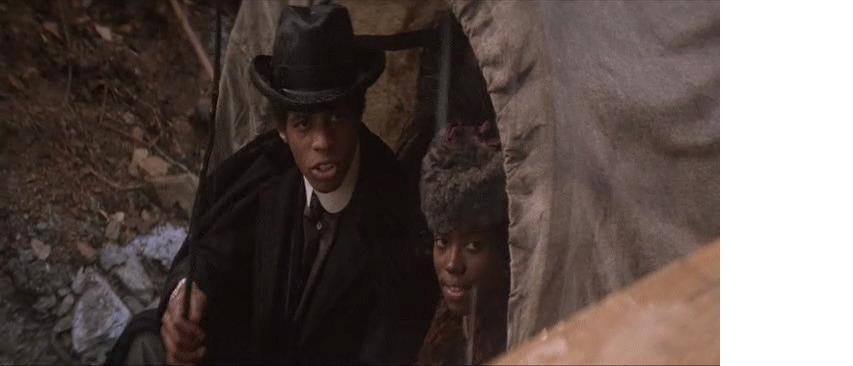 There's the Washingtons, a sedate African-American couple who mostly steer clear of the white folks' crazy fights. Instead, they do their jobs---they're the ones who actually bring in the ladies that are Mrs. Miller's capital---and keep their heads down. The most respectable citizens in town, they get the last "townspeople shot" in the movie, walking away from the celebration after the church fire has been put out; having done the work of preserving public order, they're visibly uninterested in the debauchery that keeps endangering it.
There's the Washingtons, a sedate African-American couple who mostly steer clear of the white folks' crazy fights. Instead, they do their jobs---they're the ones who actually bring in the ladies that are Mrs. Miller's capital---and keep their heads down. The most respectable citizens in town, they get the last "townspeople shot" in the movie, walking away from the celebration after the church fire has been put out; having done the work of preserving public order, they're visibly uninterested in the debauchery that keeps endangering it.
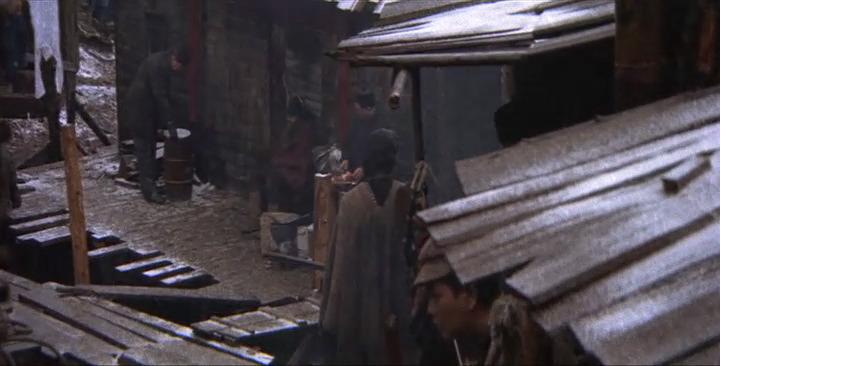 We only get a few glimpses into the Chinatown that's already taken root when the town's roads aren't even done, but they're terrifically suggestive, and the Chinese workers in Mrs. Miller's "gooseberry ranch" similarly remind the viewer who's actually building things in this outpost. I would love to see a whole feature Western set in one of these frontier Chinatowns, with the cowboys as the mysterious presence that keeps making trouble.
We only get a few glimpses into the Chinatown that's already taken root when the town's roads aren't even done, but they're terrifically suggestive, and the Chinese workers in Mrs. Miller's "gooseberry ranch" similarly remind the viewer who's actually building things in this outpost. I would love to see a whole feature Western set in one of these frontier Chinatowns, with the cowboys as the mysterious presence that keeps making trouble.
Meanwhile, the one member of the white-boy brigade who does try to build something resembling a real life, Bart (played by Bert Remsen, Altman stalwart and favorite of my estwhile co-blogger) can't keep his drunken temper and overinflated sense of honor (which would be a mark of virtue in many guy-flicks) under control, and gets himself killed in one of the dumbest streetfights in movie history. As a result, his mail-order bride (Shelly Duvall! Those eyes! Those lips!) immediately makes a beeline for Mrs. Miller in the hopes of some more lucrative work, which is, as Mrs. Miller declares in no uncertain terms, a much better deal than being Bart's wife ever was.
All this abnegation is especially appropriate considering the general mood of alienation from America-building that must have prevailed on set. McCabe was shot in Canada in 1971, and a significant number of crew and performers were draft-dodgers who'd settled in the Canadian wilderness, and could hardly have resisted the joke of playing the original American cowboys creating a land that the counterculture was increasingly giving up on.
On a completely other note (I warned you there wasn't going to be a big thesis...): I do so love the sheer muzziness of the visuals, appropriate for a movie whose protagonist is slobbering drunk most of the time, and regularly caught in the rain. This is often exaggerated beyond all reason, as in McCabe's big entrance at the end of the credits sequence, when Altman and his cinematographer decided that all the "flashed" shots just weren't fuzzy enough, and shoot McCabe's entrance through a pane of dirty glass.
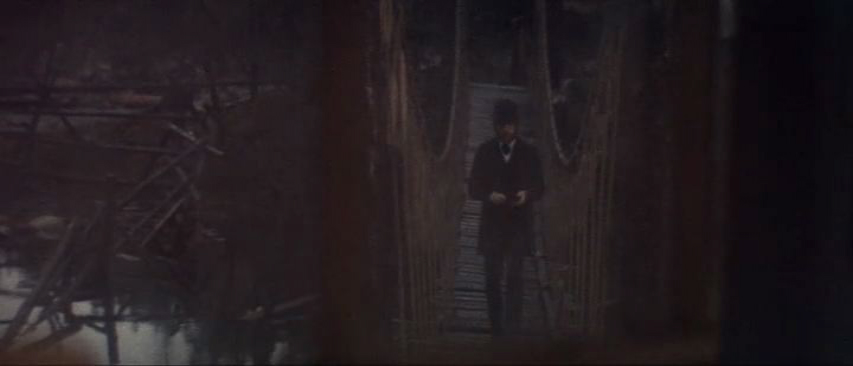
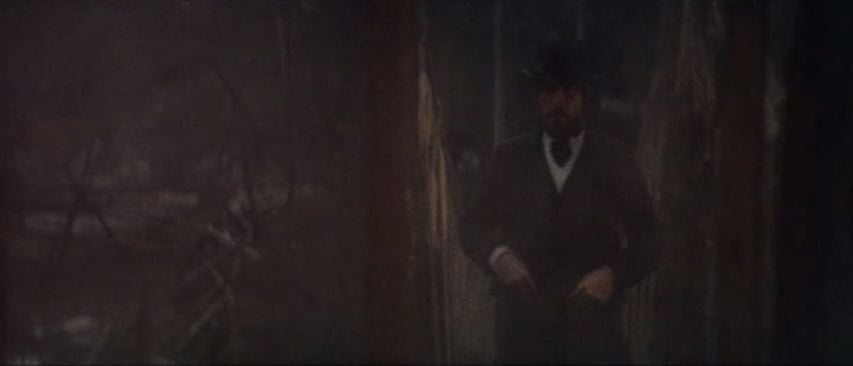
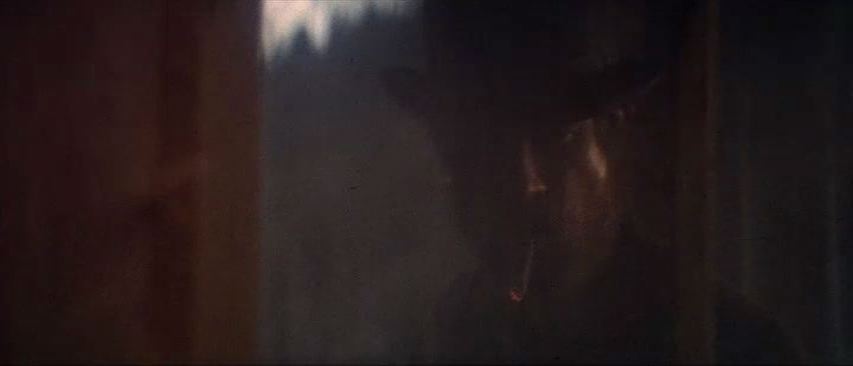
It's also interesting to note how much of the movie's visual progression is built around the introduction of color. The early scenes of the movie are a thousand shades of brown, with a look that subtley evokes sepia-toning. We then get black and white for the journey down to Bearpaw, with color mostly visible on ties and houses, symbols of civilization that seem out of place in the vast wilderness.
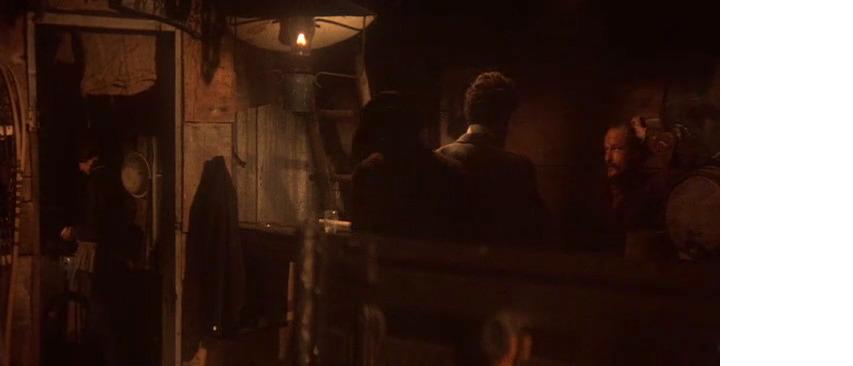
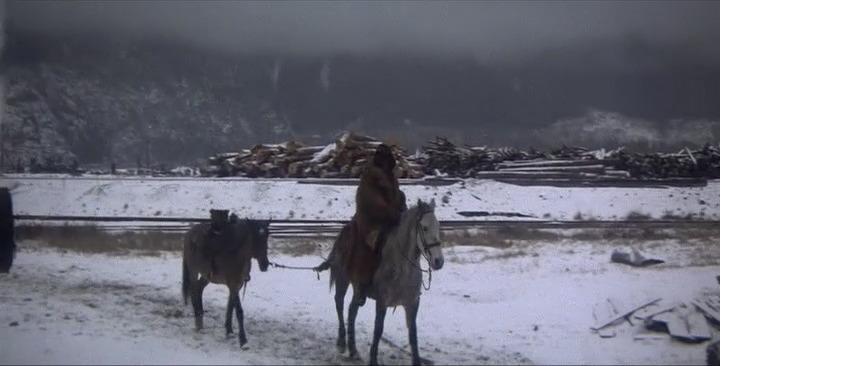
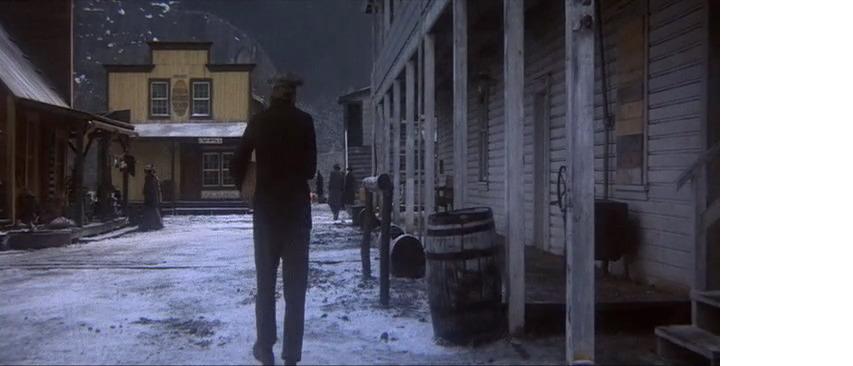
But once Mrs. Miller enters the picture, a whole new palette of colors opens up. Her high-class establishment, while still somewhat desaturated, has a much wider range of colors and tones than Sheehan's murky bar, in keeping with the wide range of possibilities it offers as its main enticement.

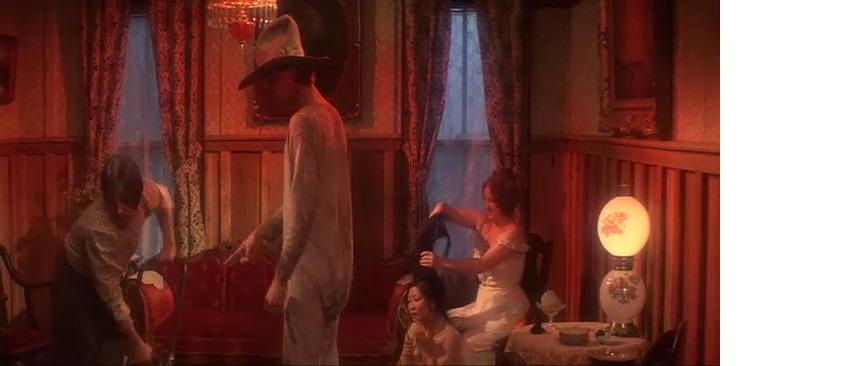
Similarly, the thugs from the mining company bring with them a bright, hard light, very different from the diffuse glow we saw earlier. This unsparing brightness, like being born into a world McCabe's been in hiding from, reaches its apotheosis in the final snowbound gunfight, where we return to a limited pallete, but this time with a light that's sharp, clear, and merciless.
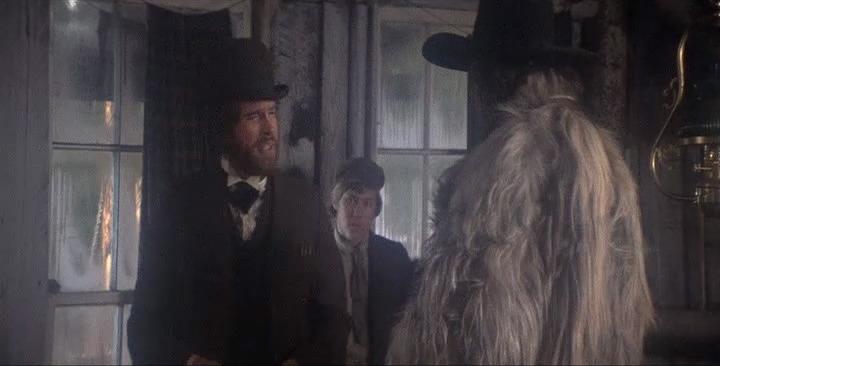
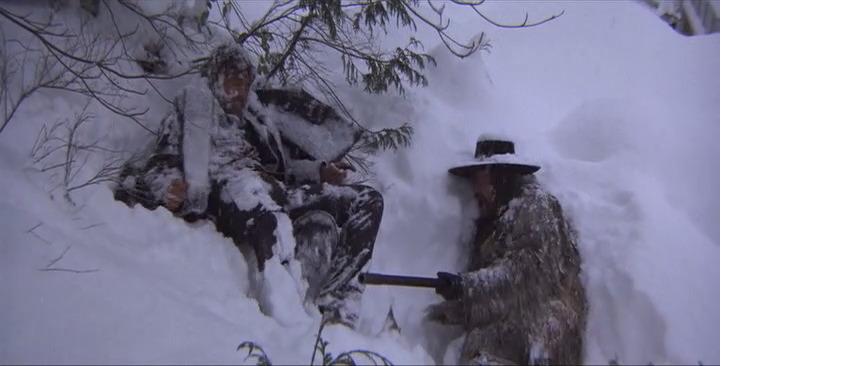
My final thought on McCabe: If it does nothing else, it really makes you realize how miserable it must have been to settle the Pacific Northwest. You're riding on horseback for days, living in shacks and tents, it's raining all the goddamn time! Unlike the majority of Westerns, which are set in the deserts of California, Arizona, and New Mexico, McCabe takes place is a world where nature is always asserting itself, not with spectacular flash-floods of disaster, but with a constant thudding of misery and muck.
A movie like this sort of makes for bad blog fodder, as I quickly lose the ability to say anything smart and can only stutter and gawp: Those performances! That cinematography! All those fantastic faces! So no attempt at a thesis here---just a few observations, and perhaps we'll get The Belgian to chime in at the comments.
When I first saw McCabe in college, the professor talked about the classic Western narrative of the guy who built the town being unable to live in it. But actually, the film's even crueler than that: McCabe really doesn't build the town at all. He shows up, buys up some property, and starts a business, but the one thing he brings that wasn't there before---a classy brothel which serves as the movie's ironic symbol of civilization---wasn't his idea at all; he just put up the capital that Mrs. Miller put to work. Ultimately, McCabe is a good-time irrelevance---not only can he not adjust to civilized life, he's not much use on the frontier either. Fortunately for Altman, he's got the immense charisma of Warren Beatty on his side; otherwise it'd be awfully hard to pay attention to what's ultimately the story of a great nonentity.
McCabe's uselessness is further highlighted by Altman's trademark generosity with minor characters. In the background of McCabe's bull sessions and drunken card games, we get glimpses of the people who are doing the real building of the town, and it's striking how different all of them are from the palefaces who would be the heroes, rogues, and general moral centers of a previous era's Westerns.
 There's the Washingtons, a sedate African-American couple who mostly steer clear of the white folks' crazy fights. Instead, they do their jobs---they're the ones who actually bring in the ladies that are Mrs. Miller's capital---and keep their heads down. The most respectable citizens in town, they get the last "townspeople shot" in the movie, walking away from the celebration after the church fire has been put out; having done the work of preserving public order, they're visibly uninterested in the debauchery that keeps endangering it.
There's the Washingtons, a sedate African-American couple who mostly steer clear of the white folks' crazy fights. Instead, they do their jobs---they're the ones who actually bring in the ladies that are Mrs. Miller's capital---and keep their heads down. The most respectable citizens in town, they get the last "townspeople shot" in the movie, walking away from the celebration after the church fire has been put out; having done the work of preserving public order, they're visibly uninterested in the debauchery that keeps endangering it.  We only get a few glimpses into the Chinatown that's already taken root when the town's roads aren't even done, but they're terrifically suggestive, and the Chinese workers in Mrs. Miller's "gooseberry ranch" similarly remind the viewer who's actually building things in this outpost. I would love to see a whole feature Western set in one of these frontier Chinatowns, with the cowboys as the mysterious presence that keeps making trouble.
We only get a few glimpses into the Chinatown that's already taken root when the town's roads aren't even done, but they're terrifically suggestive, and the Chinese workers in Mrs. Miller's "gooseberry ranch" similarly remind the viewer who's actually building things in this outpost. I would love to see a whole feature Western set in one of these frontier Chinatowns, with the cowboys as the mysterious presence that keeps making trouble. Meanwhile, the one member of the white-boy brigade who does try to build something resembling a real life, Bart (played by Bert Remsen, Altman stalwart and favorite of my estwhile co-blogger) can't keep his drunken temper and overinflated sense of honor (which would be a mark of virtue in many guy-flicks) under control, and gets himself killed in one of the dumbest streetfights in movie history. As a result, his mail-order bride (Shelly Duvall! Those eyes! Those lips!) immediately makes a beeline for Mrs. Miller in the hopes of some more lucrative work, which is, as Mrs. Miller declares in no uncertain terms, a much better deal than being Bart's wife ever was.
All this abnegation is especially appropriate considering the general mood of alienation from America-building that must have prevailed on set. McCabe was shot in Canada in 1971, and a significant number of crew and performers were draft-dodgers who'd settled in the Canadian wilderness, and could hardly have resisted the joke of playing the original American cowboys creating a land that the counterculture was increasingly giving up on.
On a completely other note (I warned you there wasn't going to be a big thesis...): I do so love the sheer muzziness of the visuals, appropriate for a movie whose protagonist is slobbering drunk most of the time, and regularly caught in the rain. This is often exaggerated beyond all reason, as in McCabe's big entrance at the end of the credits sequence, when Altman and his cinematographer decided that all the "flashed" shots just weren't fuzzy enough, and shoot McCabe's entrance through a pane of dirty glass.



It's also interesting to note how much of the movie's visual progression is built around the introduction of color. The early scenes of the movie are a thousand shades of brown, with a look that subtley evokes sepia-toning. We then get black and white for the journey down to Bearpaw, with color mostly visible on ties and houses, symbols of civilization that seem out of place in the vast wilderness.



But once Mrs. Miller enters the picture, a whole new palette of colors opens up. Her high-class establishment, while still somewhat desaturated, has a much wider range of colors and tones than Sheehan's murky bar, in keeping with the wide range of possibilities it offers as its main enticement.


Similarly, the thugs from the mining company bring with them a bright, hard light, very different from the diffuse glow we saw earlier. This unsparing brightness, like being born into a world McCabe's been in hiding from, reaches its apotheosis in the final snowbound gunfight, where we return to a limited pallete, but this time with a light that's sharp, clear, and merciless.


My final thought on McCabe: If it does nothing else, it really makes you realize how miserable it must have been to settle the Pacific Northwest. You're riding on horseback for days, living in shacks and tents, it's raining all the goddamn time! Unlike the majority of Westerns, which are set in the deserts of California, Arizona, and New Mexico, McCabe takes place is a world where nature is always asserting itself, not with spectacular flash-floods of disaster, but with a constant thudding of misery and muck.
Subscribe to:
Comments (Atom)